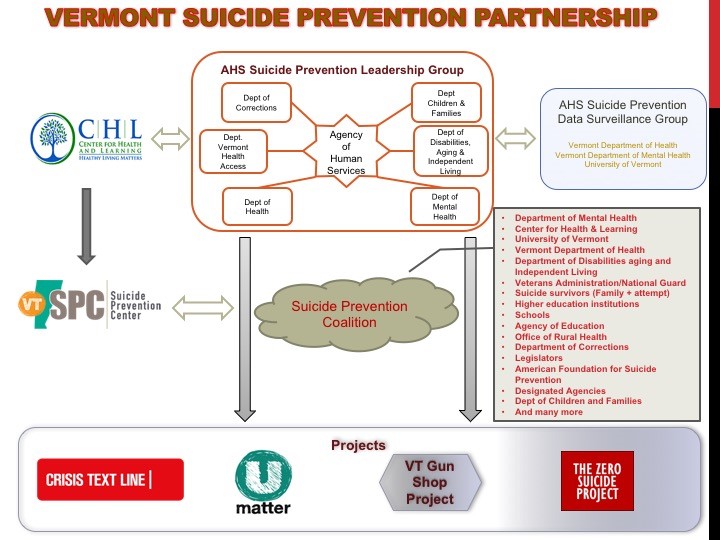Vermont's rate of suicide, calculated as the number of deaths by suicide per 100,000 people, are higher than the national averages. Vermont rate of suicide are also higher than the rates of neighboring states and the New England Region. The overall rate for the past 10 years has been increasing. In the most recent years, more than a 100 Vermonters have died by suicide. More men die by suicide than women. Firearms are the method used for nearly two-thirds of the deaths by suicide. The Agency of Human Services is currently using the scorecard to keep track of key data elements to guide our efforts at reducing the rate of suicide in Vermont. It can be accessed at the Department of Mental Health Scorecard.
Partners
The Leadership Group in alliance with the Vermont Suicide Prevention Center (VTSPC) has created a broader group entitled the Vermont Suicide Prevention Coalition where there is representation from provider groups (inpatient and outpatient) suicide survivors, family members, Agency of Human Services, Agency of Education, schools and higher educational institutions, Veterans Affairs, legislators as well as the Centers for Health and Learning. The coalition guides and informs the statewide prevention efforts.

What Works
Vermont’s suicide prevention plan aligns closely with the World Health Organization’s (WHO) suggested strategy. The plan categorizes actions into three broad categories; Universal Prevention, Selective Prevention, and Indicated Strategies essentially signifying primary, secondary, and tertiary prevention strategies. These are broad and take a population health approach to this problem.
Strategy
The Vermont Department of Mental Health (DMH) will work in partnership with the Agency of Human Services Leadership Group as well as the Center for Health and Learning (CHL) will promote interventions in all three categories i.e. Universal, Selective, and Indicated.
Universal Strategies: These are initiatives that are designed to reach the entire population.
- Increase access to healthcare
- Promote positive mental health campaign plans to accomplish the following:
- UMatter campaign plans to accomplish the following;
- Promote the message that suicide is preventable
- Equip gatekeepers with the knowledge and skills to respond effectively to those in distress
- Increase public awareness of the importance of addressing mental health issues
- Establish a broad-based suicide prevention and intervention strategy throughout Vermont
- Sponsor a media campaign to reduce the stigma associated with being a consumer of mental health, substance abuse, and suicide prevention services
- Promote positive youth development
- Put into place long-term, sustainable approaches to prevention and early intervention
Selective Prevention: These are initiatives that are meant to reach groups or populations at higher risk for any number of reasons.
- Targeted services for people at higher risk: This will include gatekeeper training as well as Mental Health First Aid training for those in key positions to identify people at higher risk. These gatekeepers will be trained in screening for depression as well as trained in screening for suicidality.
Helplines:
- Crisis services at Designated Agencies
- 211 - National Suicide Prevention hotline
- Peer-run warm line
- Domestic violence hotline
- Sexual violence hotline
- Crisis Text Line:

Indicated Strategies:
- Zero Suicide Project: A collection of interventions designed to improve care for those identified with needing help with suicidal thoughts and other related problems. Vermont has adopted the Nation Action Alliance for Suicide Prevention’s platform called Zero Suicide. The alliance defines Zero Suicide as a commitment to suicide prevention in health and behavioral health care systems, and also a specific set of tools and strategies. It is both a concept and a practice. For more information on Zero Suicide, click here.
